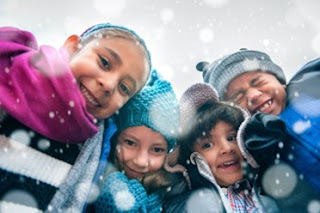This winter is proving to be a classic - lots of snow, ice, and lately slush. Now some may not be enjoying the onslaught of snow received in many communities, but most of Minnesota looks like a winter wonderland. This winter wonderland presents an excellent opportunity to engage in the outdoors, especially through learning experiences in our youth programs. Winter can truly be one of the most magical seasons for learning outdoors. And the outdoors, in my opinion, is one of the greatest learning environments, especially in winter as we may experience an otherworldly environment.
Winter blankets the Earth and opens up a different type of experience than summer. There are wonderful opportunities for outdoor science and other types of learning in the winter. It becomes a deeply sensory experience: observation of animal signs marked in the snow, whether it be sets of tracks, scat or a bedding place for overnight; listening to birds or wind moving through tree branches or, maybe, its stillness. Recently we discovered a doe and her two yearlings had bedded next to our home overnight. Their foot tracks on the unshoveled walk were first noticed, among the rabbit and squirrel tracks. We’ve been watching them since the spring, traversing through the neighborhood from one apple tree to another. This experience reminded me that environmental science and action programs are inherently linked to the landscapes where they take place even as the seasons unfold.
It is important for winter outdoor education to be thoughtful and intentional in purpose. Ask yourself, what is the focus for learning? From recreational activities like snowshoeing and cross country skiing, to educational activities like in-depth nature observation and exploring the science of snow, winter affords a novelty that we should embrace in designing learning opportunities in our youth programs. Moreover, design the learning experience to be authentic and engaging for youth by selecting a curriculum that enhances the curiosity and wonder of the season at hand.
Exploring familiar landscapes, like backyards and nearby parks, offers myriad opportunities for grounding in place-based learning. As we develop environment focused science programs, we need to be thinking not only about how youth develop critical science practices, but also about how our experiences help to move them along in understanding and feeling connected to the landscapes they inhabit and explore. That should include exploring all seasons.
As a reminder, it is equally necessary to consider the weather for safety and comfort. You may be familiar with an old adage, “There is no bad weather, only bad clothing.” For guidance on dressing for winter activities check out the resource, Teaching Outdoors in Winter.
How are you creating meaningful connections in your programs through the seasons? How are you connecting your outdoor learning to the place and the season where it takes place?
-- Rebecca Meyer, Extension educator
You are welcome to comment on this blog post. We encourage civil discourse, including spirited disagreement. We will delete comments that contain profanity, pornography or hate speech--any remarks that attack or demean people because of their sex, race, ethnic group, etc.--as well as spam

As part of our year-round outdoor education activities, Project Success has been offering winter outdoor learning for many years. Our Winter Adventure Day has been a successful way to engage young people and their families with outdoor recreation activities. https://www.projectsuccess.org/middle-school/outdoor-adventures/winter-adventure/
ReplyDelete